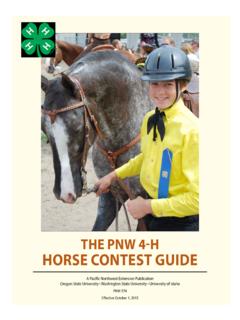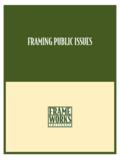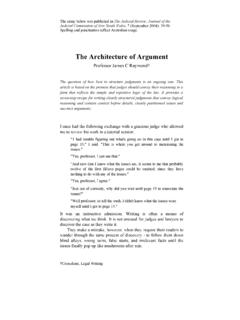Transcription of Surrealists and Anarchists, Affinities and Resistances: A ...
1 Global Review Vol. 1 No. 1 | ISSN 2291-9139 eISSN 2292-0951 Surrealists and anarchists , Affinities and Resistances: A Response to Gifford Jesse Cohn Purdue University North Central It would have been tempting, until recently, to see a certain arc of literary research as having reached its peak in 2000 with the publication of the late David Kadlec s study, Mosaic Modernism: Anarchism, Pragmatism, Culture. As James Gifford reminds us, in the decade of modernist studies before the arrival of Kadlec s book, a series of studies had undermined the simplistic division of modernist writers into a fascist Right and an anti-fascist Left by retrieving the memory of another radical politics of modernism: anar-chism.
2 These critics demonstrated that anarchism had been a primary, central influence on almost every phase of modernism, from Symbolism to Surrealism, from Picasso to Pound. Far more than the addition of a few footnotes, reinscribing anarchism within the history of culture has asked us to rethink concepts laid down by critics and theorists such as Christo-pher Caudwell, Georg Luk cs, and Antonio Gramsci, particularly the op-position of realist to abstract art, of mass to elite culture, of the public sphere to the private.
3 Anarchist-influenced forms of art often contest rigid distinctions between materialist realism and formalist abstrac-tion (Antliff, Anarchist 57). To understand the relationships among writers constituted by anarchism, we have had to trace the histories of counter-publics, coteries, and intimate circles, neither public nor merely private (Ferguson; Shaw 83; Colson 109-112). Finally, rather than situat-ing anarchisant writers by political commitments or alignments, we have had to think in terms of traditions, Affinities , and, in the word of Gifford s title, networks (L wy 14; Colson 333, 21; Day 9; Anderson 4, 233).
4 Gifford s essay, then, forms part of a fresh wave of scholarship that is now carrying this historiography of anarchist modernism forward, across the imposing boundary formed by the Second World War, into that stretch of history where the modern starts to lose its meaning. In par-ticular, new studies of the generation of American poets who came of age in the 1940s and 1950s are underlining their entanglements with anar- 108 chism ( , Bertholf and Gelpi, Duncan and Levertov). But something else seems to be happening, too.
5 The excitement of rediscovering modernism s forgotten anarchist patrimony is giving way to a more cau-tious accounting of exactly what the various moments of modernism and anarchism owe to one another. Few such analyses are more fraught than those bearing on the relation between surrealism and anarchism, the ter-rain of Gifford s explorations. The primary embarrassment for studies of surrealist engagements with anarchism has not been the supposition of an apolitical formalism, as with so many other avant-gardes, but rather in the early and very public en-gagement of surrealism with the Communist Party.
6 Notwithstanding some early signs of sympathy for anarchism ( , making anarchist assassin Germaine Berton into something like a surrealist saint), the Surrealists were painfully slow in discovering anarchism, a process that only got un-der way after the end of World War II ( , in the series of bulletins penned by Breton, P ret, and others for the anarchist journal Le Libertaire between 1947 and 1953). This much is well known; the difficulty is not insuperable, particularly if, as Fernand Drijkoningen remarks, one regards anarchism as a mindset, an attitude, even a mood, which then can be retrospectively read into the historical record of surrealism, in spite of everything (42-43).
7 The overtures of the Paris Surrealists to Le Libertaire then appears only as the belated confirmation of what has been a true af-finity from the beginning. What has been less remarked upon is the ambivalence with which these overtures were received by Surrealism is scarcely men-tioned in anarchist journals, and often mentioned dismissively in the event a mere mishmash of Freudianism and a cloudy communism, according to Victor M ric, just the latest of the avant-garde eccentricities du jour ; a form of snobism and a waste of time, for Henry Poulaille; evidence of a poverty of thought, according to Federica Montseny.
8 Signs of the physical and moral degradation of the human species in the eyes of Eugen Relgis (M ric 2075; Poulaille qtd. in Chapman 102; Montseny qtd. in Romero 26; Relgis 43; all trans. mine). These com-ments are published in loci of anarchist and syndicalist militancy: S bastien Faure s Encyclop die anarchiste (1934); Le Peuple, the newspaper of the syn- 1 Some have noted ( , Antliff, Anarchy 117-123, Cabri 53-55) that late modernists (or early postmoderns) of an anarchist tendency are themselves divided over surrealism.
9 Julian Symons, Kenneth Rexroth, and Robert Duncan, for instance, all express considerable disdain toward surrealism making a reference to the anarcho-surrealist tendencies of the Beats and Robert Duncan a little hasty (Symons 2; Duncan 62-67; Rosemont 131, 126). 109 dicalist CGT union (1924); L En dehors, E. Armand s individualist journal (1926); a pamphlet published in Mar n Civera Mart nez s Cuadernos de Cultura series, aimed at young anarchists and working-class autodidacts (1933). Why consult sources like these? Of course, it cannot be in hopes of discovering an official anarchist stance on surrealism or on anything else; no one anarchist organization or institution has that kind of exclusive and all-encompassing normative authority.
10 The opinions of individual militants such as M ric, Poulaille, Montseny, and Relgis are only of any interest insofar as they are indicative of the opinions of other anarchists ; in fact, they represent a fairly broad cross-section of the opinions we might find in the various milieus of the anarchist movement prior to World War II. They are of interest, that is, if we are concerned to ask, not only when and where and how Surrealists were able to recognize their desires in the black mirror of anarchism, as Breton put it (Free Rein 265), but whether anarchists recognized theirs in surrealism.







